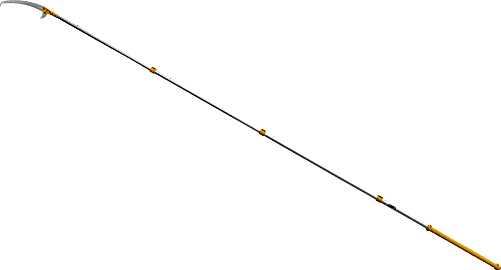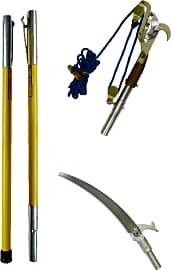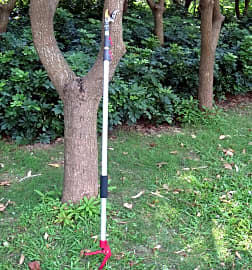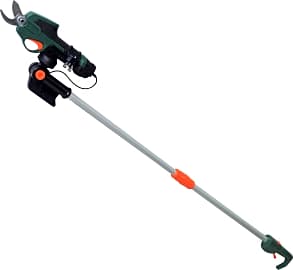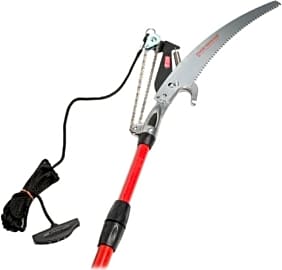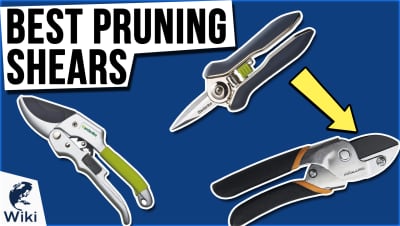The 10 Best Telescoping Pruners

This wiki has been updated 35 times since it was first published in December of 2016. With a good telescoping pruner in your hands, high branches and bushes can be readily trimmed into shape without having to clamber up a potentially precarious ladder. The extendable options on this list feature a long reach, extra-sharp blades, and a variety of cutting mechanisms designed to satisfy gardeners and landscape professionals with different needs and preferences. When users buy our independently chosen editorial choices, we may earn commissions to help fund the Wiki.
Editor's Notes
August 05, 2020:
Few things do such a good job of making a difficult task more manageable as telescoping pruners. They completely eliminate the potential safety issues of climbing high up on a ladder, so you can chop off those previously out-of-reach branches while keeping your feet firmly planted on the ground. Since a big part of these telescoping pruners is the convenience they offer, we looked for features that really add to that. We also wanted to make sure the models we choose felt nice and sturdy in the hands.
Reach is obviously a very important factor, so the Fiskars Chain Drive Tree Trimmer and Silky Hayate 372-42 received high marks. The former is 15 feet at full extension, and the latter is 20. Despite being impressively long when fully extended, they both have very little flex so you'll feel comfortable putting pressure on them. The Milliard Three-Sided also offers a 16-foot reach, however it shouldn't be used for any heavy-duty jobs when at full extension because it can feel a little flimsy. We generally recommend not extending it all the way.
If you don't need to get at branches more than 10 feet or so in the air, and want the flexibility to use a single tool for both high-up and ground-level pruning, the Scotts Outdoor PR17216PS is an obvious choice. Not only is it battery-operated, so it requires very little manual effort on your part, but its head can be removed from the pole for use as a pair of regular pruning shears.
If you need to cut through thick branches of dense wood, we recommend the Sun Joe SWJ800E, which is essentially an electric chainsaw on a pole. The Fiskars Chain Drive Tree Trimmer, Silky Hayate 372-42, Jameson FG-Series Manual, Milliard Three-Sided, and Corona RazorTooth TP 6870 Max also feature saws, but they are manual and will require a bit of elbow grease.
We want to take a moment to note that the Silky Hayate 372-42 and Jameson FG-Series Manual don't technically perfectly fall into the category of telescoping pruners, the former being more of a pole saw and the latter utilizing extension pieces rather than a telescoping mechanism, but we felt they could still be useful for anyone looking for a telescoping pruner and thought them worthy of including on the list.
June 21, 2019:
If you have a garden or yard of any sort with tall bushes or trees, or if you're a landscaper by trade, chances are you're going to need a pruner that extends to chop out-of-reach branches. The telescoping pruners featured here are surprisingly varied. There are options that are operated via a pulley system, where you yank a rope to close the blades around a branch, in addition to trigger-style models. We even found a pruner that has a mini chainsaw on the end. Whatever your preferred method of clearing excess foliage, there's definitely something in this comprehensive list for you.
The EasyGoProducts Lopper and DCM Cut and Hold got the ax because of availability issues, while the Zenport Anvil was removed due to its being more of a lopper than a pruner. The Fiskars Chain Drive has also been removed due to complaints concerning safety. Because of its durability and popularity, we've moved the Fiskars ExtendableTree to the number one spot. Finally, there are two new additions: the ARS Razor Edge and Jameson FG-Series Manual, the latter of which features the aforementioned pulley system.
Special Honors
Stanley Heavy-Duty Tree Pruner While the Stanley Heavy-Duty Tree Pruner may not offer an special or amazing features, it is a well-made, budget-priced model that can get the job done. Its fiberglass pole extends to a maximum length of 12 feet, and its steel pruning blades have a non-stick coating to minimize the chances of them gumming up from sap. homedepot.com
A Tool With Extensive Benefits
Using a standard hand shear on large plants, you’d have to routinely climb and reposition a ladder and contort your body to access tight spaces.
Those of you who maintain a property with a healthy amount of greenery are already acutely aware of the importance of regularly pruning shrubs, flowers, trees, and even fruits and vegetables.
If your landscape’s assortment of plant life is limited to flower beds, hedges, relatively small shrubs, and a modest vegetable garden, a simple set of hand shears will probably get the job done. However, once you decide to take on trimming tree limbs, large bushes, and any other plants that tower over you even when you’re standing, a quality telescoping pruner will make all the difference in the world.
Of the thousands of ladder-related injuries recorded each year, the clear majority occur at home or on a farm. Knowing this, why decide to take an unnecessary risk? With a pruning tool that extends several feet, you won’t have to rely on a ladder — you’ll be able to safely reach branches with your feet firmly planted on hard, solid ground.
The usefulness of a telescopic handle extends beyond trees and tall plants — it also comes in handy when obstructions stand between you and your target. For example, if you’re forced to reach through a thorny bush or a thin fence opening, a long handle will make the process significantly easier, and you won’t come away with nicks and scrapes when you’re finished.
Speaking of aches and pains — your body will thank you for picking up one of these tools. Using a standard hand shear on large plants, you’d have to routinely climb and reposition a ladder and contort your body to access tight spaces. When wielding an extending pruner, there’s no need to stretch, lean, or crawl around, and you’ll be able to complete more work in a given amount of time. This means more productivity and less fatigue.
It also means you’ll be able to enhance the health of plants and trees that you otherwise wouldn’t have been able to help. Overgrown greenery not only faces challenges in developing at a healthy pace, it’s at greater risk for contracting diseases. Improving air circulation and the passage of sunlight will result in better growth and more lively plants.
Different Pruners For Different Plants
Telescopic pruners are available in several different designs, and you'll want to consider what you'll be trimming before making a selection.
A pruner with a saw attachment is the obvious choice for slicing through tough, thick tree branches, as its tapered blade with razor-sharp teeth is ideal for jobs that require a bit of power. Keep in mind that these can be difficult to use in a dense tangle of branches, as the blade tends to get caught.
Telescopic pruners are available in several different designs, and you'll want to consider what you'll be trimming before making a selection.
For those of you accustomed to power tools, an electric model will suit your style nicely. Powered by a motor, these can cut through limbs up to several inches thick, thanks to a mini chain saw system at the end of the pole.
Bypass models feature two curved blades that bypass each other, much in the same way as a pair of scissors. This style usually produces a clean, straight cut, which helps you avoid injuring the plant or tree and allows the branch to effectively begin the healing process.
Anvil pruners operate like a knife on a cutting board, with a single cutting blade that closes down over a flat edge. Ratchet pruners are essentially anvil pruners with extra versatility, as they use a ratcheting mechanism to offer more leverage and reduce the amount of effort you must put forth to achieve a cut.
Whatever types of plants you’ll be cutting, you’ll want your blades to be strong and sharp. You'll also want the shaft to feature a reliable locking system, so you can be confident that it will remain securely in place as you go about your pruning.
When you’re assessing the tools available to you, try to find one with blades that are treated to resist sticking, so you won’t have to constantly wipe off brush and leaves as you work. Some options come with lifetime warranties, which is worth considering, as well.
Pruning Tips And Tricks
Most plants benefit from regular pruning, but if you’re not at least somewhat familiar with how and when you should be employing this tactic, you’ll be limited at best in your success.
If you’re willing to spend a little extra cash, some high-end options even contain built-in automatic oiling mechanisms, which help save you time and energy.
Trimming fruiting and flowering plants is most advantageous while they are dormant — which means you’re looking at late winter through the early spring months. On the other hand, some trees and shrubs that bloom in the spring prefer to be pruned shortly after flowering. By predetermining the best time to prune your specific plants, you’ll be able to develop an annual strategy for fostering consistent growth.
Once you’ve put together a plan of action, you’ll have to execute it out in the fresh air. Make sure you know how to properly hold and utilize your tool. For example, with bypass pruners, you’ll want to face the hooked side of the blade away from the plant. Using this approach, if the hook does damage any part of the plant, it will be the section that you’re lopping off.
You should try to always wear gloves and protective eye gear when using these tools. Sharpen the blades regularly, as your pruner will not operate nearly as efficiently as it should if its blades are dull. In addition, the cleaner the cut you make, the faster the plant will heal, which leads to healthier growth.
Cleaning the tool after every use is advisable; scrubbing it with bleach or alcohol will help remove any contaminants that could potentially lead to corrosion or disease. If you’re willing to spend a little extra cash, some high-end options even contain built-in automatic oiling mechanisms, which help save you time and energy.



